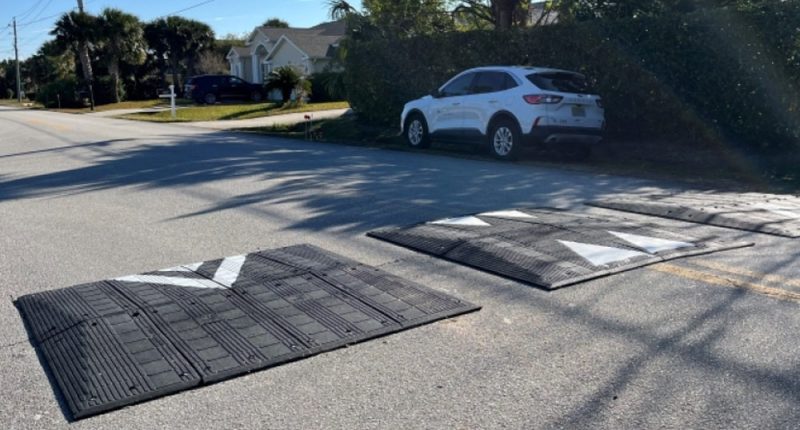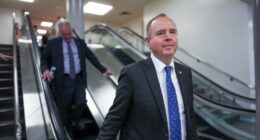
Palm Coast government will develop a process to let residents request traffic-calming measures on certain streets almost citywide.
The Palm Coast City Council’s decision is the result of a $100,000 pilot study that included installing three different traffic-calming methods in several reas, among them speed cushions on Florida Park Drive and Cimmaron Drive.
The cushions will be removed from Cimmaron: residents did not like them. They will remain on Florida Park Drive, and alternate methods such as speed tables, which are gentler on cars than speed cushions, might be studied, though speed tables are not conducive to good drainage.
The council this evening directed the administration to develop a manual that would be central to an overall plan. The manual would enable neighborhoods to apply for traffic-calming measures tailored to their neighborhood. It would include criteria for calming options, public education strategies, and technical specifications. The city would analyze each request and determine whether desired options are feasible and affordable.
At least three council members–Mayor Mike Norris, Council members Theresa Pontieri and Charles Gambaro–are also interested in reducing speed limits on all neighborhood streets from 30 to 25 miles per hour. Council member Dave Sullivan spoke favorably of the idea, comparing it to what Flagler Beach did last year: it lowered its citywide speeds to 20.
Acting City Manager Lauren Johnston said signs would have to be installed on every street. That would cost close to $2 million, though she will provide a more precise estimate in a follow-up meeting.
“This traffic calming thing was, quite candidly, one of my babies. Because I’m very concerned,” Pontieri said. “When I was campaigning, walking up and down Florida Park Drive and Cimmaron, knocking on doors, I was mortified.” She said she would not want to walk her dog there, or walk with her child there.
“I do want us to move forward setting up a traffic calming manual and getting an application process done, then leave it to the residents.” But she’s also in favor of lowering speed limits to 25 miles per hour, even if it’s costly–if the council decides to make it a priority. “So in my mind this analysis is not done yet,” she said, between that and looking at additional calming methods. She also noted that “inconveniencing people is worth slowing them down a little bit if it’s working.”
Norris was displeased with spending as much money as the city did on a traffic study. “We could have the sheriff’s department just have someone sit on a point with the radar and clock vehicles and get that data through an investigation, instead of investing all that money in a traffic study,” he said. That method could in turn justify lower speed limits.
He also wants to encourage the school district to remove bus stops from thoroughfares like Cimmaron and Florida Park Drive. Pontieri and Gambaro support that approach, with more direct contact between the city and the school district. Gambaro said his “first inclination is to lower speed limits, period.” He also favors the traffic manual.
But no additional traffic-calming devices will be appearing for now.
“We’re not deciding speed bumps on this road or speed bumps on this road today,” Council member Ty Miller said. “We’re deciding what the framework is for you to request them on your road, so to speak. You’ll be making that decision along with your neighbors.” About 70 roads would qualify as collector roads fit for traffic-calming devices. Neighborhood streets in subdivisions would not.
Numerous people addressed the council, voicing much opposition to the calming devices on Cimmaron, among other things, but otherwise expressing wide-ranging opinions.
Fire Chief Kyle Berryhill said there’s not yet enough data to determine how the speed cushions are impacting response times. The cushions are engineered in such a way as to allow emergency vehicles to pass without hitting the cushions, but those cavities have to be fine-tuned.
A speed study was completed in June 2024. It showed high speeds across the city. The council asked for a traffic-calming plan, with Florida Park Drive and Cimmaron Drive chosen for a pilot program.
Speed cushions that look like speed bumps, chicanes–sticks that narrow the lane–and actual lane-narrowing were the three systems chosen for the pilot study. Speed cushions were installed on Florida Park Drive and Cimmaron Drive. Chicanes were installed on Forest Grove and Farnsworth Drive. Lane narrowing by striping was done on Sea Trail and Woodbury Drive. Data was collected at all points.
The study found the speed cushions to be “very effective” on Florida Park Drive and Cimmaron, lowering speeds by several miles per hour. Vehicles almost never managed to return to the kind of speeds vehicles drove without the cushions. The chicanes were “somewhat effective.” The lane narrowing was not effective. (It costs more to stripe a road than to install cushions.)
The study included public surveys on all roadways studied. A caveat: the survey was not scientific. It did not control for respondents who repeatedly took the survey. So it could have been gamed. The council is looking to develop a better-controlled survey option, such as voting through an individualized app, which would prevent multiple votes.
The survey on speed cushions drew 916 responses. Residents overwhelmingly opposed speed cushions, with close to 70 percent of respondents not wanting them. While 34 percent want to see no changes (no speed cushions), 23 percent wanted to see slower vehicle speeds. Most found the speed cushions ineffective. Lane narrowing and chicanes did not get favorable responses. See the full survey results in the document below.
![]()
traffic-calming-study






